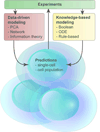Demystifying the cytokine network: Mathematical models point the way
- PMID: 27919524
- PMCID: PMC5457394
- DOI: 10.1016/j.cyto.2016.11.013
Demystifying the cytokine network: Mathematical models point the way
Abstract
Cytokines provide the means by which immune cells communicate with each other and with parenchymal cells. There are over one hundred cytokines and many exist in families that share receptor components and signal transduction pathways, creating complex networks. Reductionist approaches to understanding the role of specific cytokines, through the use of gene-targeted mice, have revealed further complexity in the form of redundancy and pleiotropy in cytokine function. Creating an understanding of the complex interactions between cytokines and their target cells is challenging experimentally. Mathematical and computational modeling provides a robust set of tools by which complex interactions between cytokines can be studied and analyzed, in the process creating novel insights that can be further tested experimentally. This review will discuss and provide examples of the different modeling approaches that have been used to increase our understanding of cytokine networks. This includes discussion of knowledge-based and data-driven modeling approaches and the recent advance in single-cell analysis. The use of modeling to optimize cytokine-based therapies will also be discussed.
Keywords: CD4 T cell differentiation; Cytokine networks; Mathematical modeling; Single-cell analysis.
Copyright © 2016 Elsevier Ltd. All rights reserved.
Figures

References
-
- Ozaki K, Leonard WJ. Cytokine and cytokine receptor pleiotropy and redundancy. J. Biol. Chem. 2002;277(33):29355–29358. http://dx.doi.org/10.1074/jbc.R200003200. - DOI - PubMed
-
- Spangler JB, Moraga I, Mendoza JL, Garcia KC. Insights into cytokine-receptor interactions from cytokine engineering. Annu. Rev. Immunol. 2015;33(1):139–167. http://dx.doi.org/10.1146/annurev-immunol-032713-120211. - DOI - PMC - PubMed
-
- West NR, McCuaig S, Franchini F, Powrie F. Emerging cytokine networks in colorectal cancer. Nat. Rev. Immunol. 2015;15(10):615–629. http://dx.doi.org/10.1038/nri3896. - DOI - PubMed
-
- Brzustewicz E, Bryl E. The role of cytokines in the pathogenesis of rheumatoid arthritis–practical and potential application of cytokines as biomarkers and targets of personalized therapy. Cytokine. 2015;76(2):527–536. http://dx.doi.org/10.1016/j.cyto.2015.08.260. - DOI - PubMed
-
- Neurath MF. Cytokines in inflammatory bowel disease. Nat. Rev. Immunol. 2014;14(5):329–342. http://dx.doi.org/10.1038/nri3661. - DOI - PubMed
Publication types
MeSH terms
Substances
Grants and funding
LinkOut - more resources
Full Text Sources
Other Literature Sources
Research Materials

